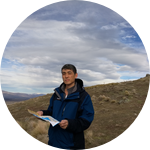About This Project
Transportation induced air and noise pollution is a major concern for cities around the world. Children, elderly, and people with heart or lung diseases are the most vulnerable populations. However, this concern has not been well connected to people's daily life. This experiment will measure and demonstrate the dynamic association between roadway traffic conditions and the spatial distribution of air quality. The goal is to increase the awareness of this issue among the general public.
Ask the Scientists
Join The DiscussionWhat is the context of this research?
Transportation induced air and noise pollution is a major concern for cities around the world. Studies have shown that black carbon, a byproduct of incomplete combustion, can cause human health problems, such as difficulty breathing, which has been increasingly drawn attention from the scientists to the environmental policy makers. Nitrogen dioxide (NO2) can cause respiratory irritation. Noise, although not well studied, can significantly affect human health and quality of life. Children, elderly, and people with heart or lung diseases are the most vulnerable populations. However, this concern has not been well communicated to the general public.
What is the significance of this project?
Traffic congestion and air pollution are two major problems in cities because of their impact on people's well-being and health. While most people are aware of these problems we often pay more attention to traffic congestion and rarely consider air pollution in our daily travel decision-makings. This experiment will measure and demonstrate the dynamic association between roadway traffic conditions and the spatial distribution of air quality. The result will be visualized with various data representation methods and provide evidence of the traffic-induced air quality issue in the context of everyone’s daily life. An improved understanding of this issue will be an effective way of empowering science-based public participation in city planning, urban design, and infrastructure management.
What are the goals of the project?
Students enrolled in a Sustainable Urbanism course at the University of Cincinnati will use low cost sensors to measure air quality in different urban areas (residential or commercial) at different traffic conditions (rush hours and non-rush hours, weekdays and weekends, days and nights) at different distances to various roadways (local, arterials, collectors, and freeways). Traffic conditions will be recorded with video cameras. The measured data will be entered into Geographic Information System for analysis and the results will be visualized through maps, animations and interactive media. The goal of the project is to visually demonstrate the association of transportation and air quality in an easily understandable format to increase the awareness of this issue among the general public.
Budget
The budget items are essential for collecting air quality and traffic data by university students. Students will use university facilities for data analysis and presentation. Studies have shown that black carbon, a byproduct of incomplete combustion can cause human health problems such as difficulty breathing and have been increasingly drawn attention from the scientists to the environmental policy makers. Nitrogen dioxide (NO2) can cause respiratory irritation. Noise, although not well studied, can significantly affect human health and quality of life.
Endorsed by
Meet the Team
Team Bio
We have been working as a team teaching the Sustainable Urbanism course for four years. The course emphasizes on supporting the simultaneous development of social and economic institutions while maintaining critical elements of the natural environment. Through interdisciplinary field studies, the course provides students with experiential learning in current theories, models and methods used in science, engineering, architecture and planning to specific issues of sustainable urbanism.
Xinhao Wang
I am a professor in the School of Planning and Co-Director of the Joint Center of Geographic Information Systems and Spatial Analysis at the University of Cincinnati. I teach courses in Geographic Information System (GIS), environmental planning, statistics, and research methods. My research interests are in the areas of environmental planning and integrated applications of GIS, visualization, and modeling in planning and urban studies, such as environment and ecological protection, housing and urban livability, land-air and land-water modeling as well as river and watershed water modeling. Prior to the University of Cincinnati, I worked as a planning, environment, and GIS consultant in China and the United States. His recent passion is to promote healthy and resilient urbanization using ecological wisdom and ecological aesthetics principles. You may find my publications in journals in environmental, planning, and geography. I commit to respecting nature, seeking harmony between nature and humans, and pursuing a good life inspired by love and guided by knowledge.
Ming Tang
I am a registered Architect, and a tenured Associate Professor at School of Architecture and Interior Design, University of Cincinnati. I am also the founding partner of TYA Design, which has won numerous design awards in China, Spain, Mexico, U.K. and United States, including, the first prize of d3 Natural System, the first place of Cities with Soul, the first place of IAAC self-sufficient housing contest, the first place of Chichen Itza lodge museum design.
Before I taught at the University of Cincinnati, I led the Electronic Design program ( Digital Design + Computation) at the Savannah College of Art and Design and was a professor in the Architecture Department. I have worked with Michigan State University's M.I.N.D Lab, University of Southern California's Institute for Creative Technologies, and China Architecture Design & Research Group. I hold Master of Architecture Degree from Tsinghua University, Maser of Art Degree in Digital Media and Technology from Michigan State University, and Maser of Final Art degree in Interactive and Game Design from Savannah College of Art and Design. My multi-disciplinary research includes parametric design, digital fabrication, building information modeling, performance driven design, digital computation, virtual reality, algorithm & programming, GIS, simulation, mathematical form, interactive design and visual effects. My research has been published in various international conferences, journals, books and exhibitions. I am the author of the book,Parametric Building Design with Autodesk Maya, published by Rougtledge in 2014. and urban paleontology, evolution of urban forms, published in 2008.
Mingming Lu
I am a tenured Associate Professor with the Dept of Biomedical, Chemical and Environmental Engineering, University of Cincinnati. I specializes in air pollutant measurement and characterization. I have studied diesel emissions from non-road sources, which tend to be more polluting than on-road diesel trucks. I have studied transportation impacts on air pollutants, such as carbon monoxide, particulate matter and black carbon. I have measured air pollutant emissions from trains and buses with portable instruments in a backpack, when I traveled to China and Singapore. I teach courses in air quality and sustainability. I have been actively involved in various educational activities, at the university, with professional organizations and also in the community. I received the College of Engineering and Applied Science Master Educator Award in Spring 2015, and the American Chemical Society Committee on Environmental Improvement, Award for Incorporating Sustainability into Chemistry Education in Oct. 2013.
I am passionate about the air monitoring in a backpack idea, and want to see communities able to know the quality of the air they breathe in real time.
Lab Notes
Nothing posted yet.
Additional Information
After four years of successful teaching, the Sustainable Urbanism coursewill be offered in 2017 as part of the University Honors program at the University of Cincinnati. Students in the program are among top 7% of the undergraduate students who are committed to community engagement, creativity, global studies, leadership, and research.
Project Backers
- 3Backers
- 1%Funded
- $24Total Donations
- $8.00Average Donation



